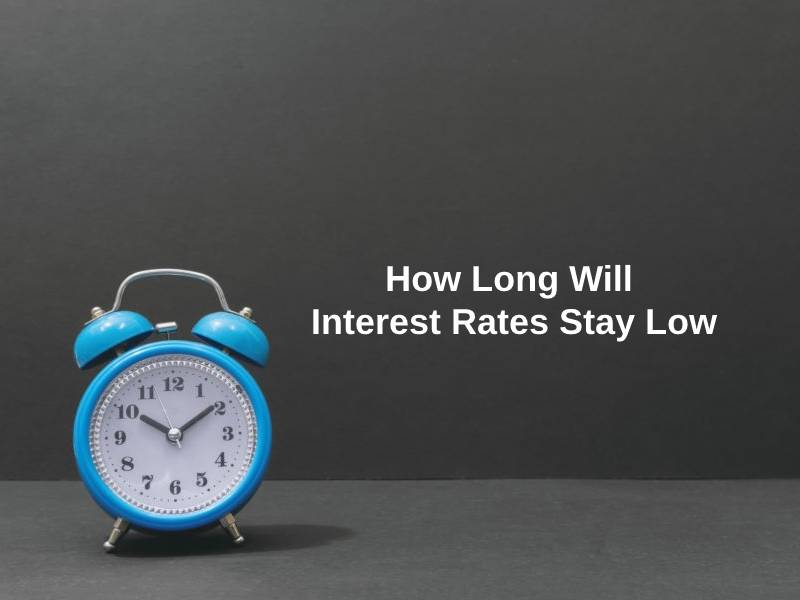Exact Answer: Until 2023
Until at least the next 2 years, interest rates are projected to stay low. The federal funds rate, which is the overnight borrowing rate for banks, will remain at zero, as per the chairman of the Federal Reserve, until inflation reaches 2% and “full employment” is achieved. For many years, the Federal Reserve’s favoured inflation gauge has been below 2%.
Unemployment will most likely remain high for a few years. Some businesses will never recover, while others will gradually rehire. It’s reasonable to expect interest rates to remain low until the economy improves considerably.

How Long Will Interest Rates Stay Low?
| Prediction | Year |
| Former Prediction | Until 2024 |
| New Prediction | Until 2023 |
Lower interest rates benefit businesses and farmers as well because they encourage them to make significant equipment purchases. After all, financing costs are low. As a result, productivity and output rise. Borrowing is less expensive when interest rates are low. This encourages people and businesses to take out more loans and spend more money.
In this circumstance, the rate of inflation tends to climb, lowering your money’s purchasing power. Consumers would like to save because they obtain a better return and borrow less since borrowing is expensive if interest rates are high. In this case, the rate of inflation will most likely decrease, ensuring that your cash’s purchasing power remains stable.
The Federal Reserve expects to raise interest rates twice by the end of 2023, according to the central bank’s latest summary of economic estimates released on Wednesday. Formerly, more than half of authorities predicted that rates would remain near zero until at least 2024, where they have been since March 2020.
Rates are expected to rise to 0.6 percent by the end of 2023, up from 0.1 percent currently. The Fed’s increasingly upbeat view of the economy is due in part to the fact that vaccines have become more widely available in the United States, reducing the chance of another wave of coronavirus illnesses bringing the economy to a halt.
Why Are Interest Rates Low For That Long?
Adjustments in interest rates can help or hurt the marketplace. Central banks routinely change their benchmark interest rates in response to business activity, increasing them whenever the market is too strong and dropping them when it is too sluggish. So when the Fed changes the rates with which banks in the country borrow funds, it involves the overall economy.
The presence of interest helps borrowers to spend money right away rather than waiting to save up for a purchase. If the interest rate on a loan is low, people are more inclined to loan money to finance significant purchases like homes and cars. Customers who pay little interest have more cash to spend, which can result in an increase in total economic spending.
Lower borrowing rates benefit both businesses and farmers since they stimulate them to make substantial investments. Low-interest rates aren’t a new phenomenon. Since the global economic crisis more than a decade earlier, short-term interest rates have been lower.
The Covid-19 pandemic, on the other hand, has driven them even lower as central banks go “all in” to promote economic activity. Official policy rates in the United Kingdom are now at historic lows, the lowest since records began, while in the eurozone, they remain below zero.
In the current climate, as the economy returns from recession, the Fed should keep rates low and policy lose for a while in order to meet its new goal. A move like this would also offer the Fed a better chance of meeting its maximum employment goal, which would see a larger set of individuals and communities benefit from economic growth.
Conclusion
Even though the world economy is likely to speed away from last year’s coronavirus-induced recession in 2021, central banks are predicted to sustain their ultra-easy monetary strategies. No large western central bank is projected to increase interest rates this year, according to Bloomberg’s quarterly update of monetary policy, which covers 90% of the global economy.
Prior to exploring tightening policy, central bankers are expected to want to make sure the rebound is stable. The main reasons for delaying include the ongoing uncertainty about the virus’s progress, as well as high unemployment and low inflation. Even if inflation rises this year, central banks will most likely try to look past it.
References
- https://www.ijcb.org/journal/ijcb17q3a1.htm
- https://search.proquest.com/openview/8b6f9c3f032443ae788f6260a9415a95/1?pq-origsite=gscholar&cbl=41200
- https://www.cambridge.org/core/journals/macroeconomic-dynamics/article/do-banks-take-unusual-risks-when-interest-rates-are-expected-to-stay-low-for-a-long-time/4DF34126642DC81B18EE5092AD41C68F